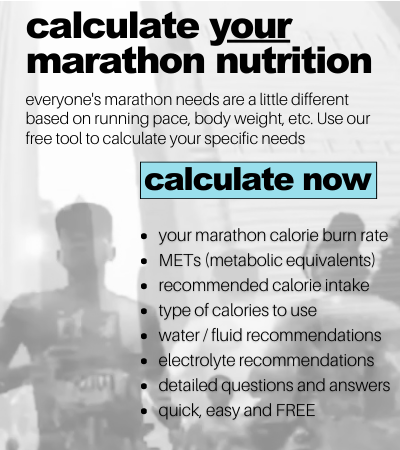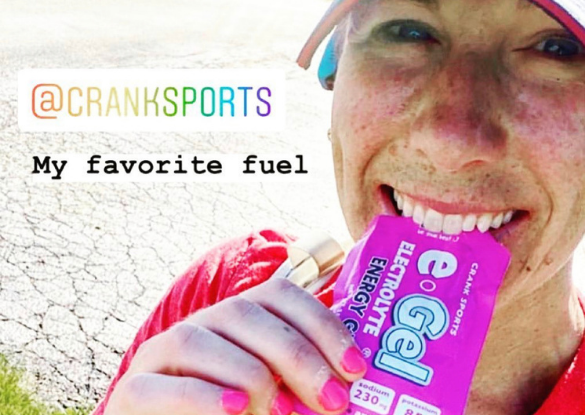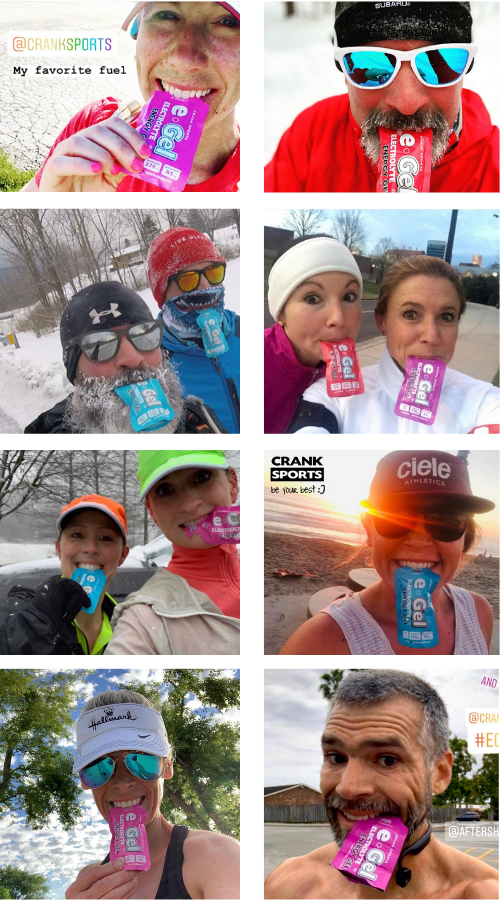Marathon Wall
The marathon "wall" and how to avoid it!
Take 2 minutes to read to the end … on race day you’ll be happy you did! If you cramp, bonk (run out of energy), have stomach issues or have to go to the bathroom during your marathon, use our Sherpa Guide to solve your problems. To find out your energy, hydration and electrolyte requirements during a marathon, use our Sherpa Analysis tool.
Take 2 minutes to read to the end … on race day you’ll be happy you did!
your fuel tank
Your glycogen stores (energy stored in your muscles and liver) are your primary source of energy when running a marathon. When you properly carbo load your glycogen stores will have approximately 2,000 calories, regardless of your body shape and size. Think of your glycogen stores as your “on-board fuel tank”. When your tank runs out you’ll have to rely primarily on body fat as fuel. One pound of body fat contains enough energy to run approximately 40 miles, so we all have plenty of fat to finish a marathon. The problem is that fat is a “survival fuel” … it’s designed to keep you alive. Fat is not a good source of fuel for high performance and it is slow to convert into usable energy. So if all you have left is fat, you’ll still be able to move but you’ll feel like a ton of bricks. You’ve just hit the wall!
why is the wall around mile 20?
When you run you burn approximately 100 calories per mile, give or take about 10% depending on body type, running pace, conditions, etc. So if you do the math at 100 calories per mile, after 20 miles you will have burned about 2,000 calories and your tank will be empty.
To calculate your individual needs, use our calculator (click below)
why is the wall around mile 20?
When you run you burn approximately 100 calories per mile, give or take about 10% depending on body type, running pace, conditions, etc. So if you do the math at 100 calories per mile, after 20 miles you will have burned about 2,000 calories and your tank will be empty.
To calculate your individual needs, use our calculator (click below)
what's the solution?
To avoid hitting the wall you’ll need to take in a minimum of 600 to 700 calories during the event. It’s vital that the calories you consume while running are rapidly absorbable, meaning that you’ll want liquid calories from sports drinks or energy gels. Read below to learn why you should avoid solids (fat, fiber and protein) and you should use complex carbs instead of simple sugars.
SHORT ANSWER
Fats, fibers and proteins have to go through a full digestive process, thus taking oxygen away from your working muscles.
LONG ANSWER
If you remember the Lance Armstrong scandal, it was all about blood doping. By illegally increasing the amount of oxygen in your blood, more oxygen is then provided to the muscles. The more oxygen you have available the better you will perform, period. Likewise, if you reduce the available oxygen to the muscles your performance will suffer.
When your are training or competing, your body is amazingly adaptive and it does everything it can to help you out. One way it does this is by drawing blood form parts of your body that don’t need it at that time so that it can route more blood (and therefor oxygen) out to the working muscles. A large user of blood is your stomach and intestinal tract, and it will draw on this blood supply.
The beauty of e-Gel is that that it is absorbed via osmosis (with water) instead of going through a full digestive process. However, when you consume anything with fats, fibers or protein, these ingredients must be digested. This means that your body has to route blood back to the stomach and intestines for the digestive process, thus taking blood and oxygen away from the working muscles.
If you are trying to set a personal best, run a qualifying time, etc., consuming something that takes away from your performance, even a little bit, should be avoid if possible.
SHORT ANSWER
Because your body can uptake more energy when you use complex carbs instead of simple sugars. If you’re doing any kind of endurance sport, then the more energy you can get from your nutrition the better you’ll perform. Period. e-Gel has more complex carbs than any other gel, check out our comparisons
LONG ANSWER (or watch this video)
The carbs/energy in an energy gel are transported into your cellular system through osmosis. If you recall learning about osmosis in science class, it’s the way a fluid crosses a membrane. In order for the fluid to cross, it has to be an equal or lower concentration than the fluid on the other side of the membrane. In this case you’re trying to get the gel across your cellular membrane so you can use the energy. Gels by themselves are extremely concentrated (hypertonic), that’s why you need to use water with gel so that you can lower the concentration until it becomes isotonic (the same concentration as your cellular fluids). When you do, the gel and water get absorbed – osmosis!!
What’s interesting is that the concentration of a fluid (also called the osmolality) is largely dependent on the NUMBER of particles in the fluid, and less dependent on the size of the particles. Complex carbs by definition have a larger molecular structure than simple sugars, basically they have more glucose molecules stuck together. But remember, it’s the number of particles, not the size that matters most. What that means is that at the point of absorption (isotonic), a fluid with complex carbs can transport nearly twice as much energy into the cellular system compared to one with simple sugars.
This isn’t something that we’ve invented here a Crank Sports, it’s proven science. Many energy gels (including e-Gel) use at least some maltodextrin for this reason. Maltodextrin is a complex carbohydrate with an extremely large molecular structure. Where e-Gel sets itself apart from other products is that we use much more complex carb and less sugar (read about sugar below). This allows you to get more energy when you use e-Gel compared to our competitors. Why do other companies use so much sugar? Simple, because it’s sweet and inexpensive, and sweet things sell. So if you want to sell a lot of something you make it sweet. But if you want to make the best PERFORMING product you use complex carbs.
why is the wall around mile 20?
When you run you burn approximately 100 calories per mile, give or take about 10% depending on body type, running pace, conditions, etc. So if you do the math at 100 calories per mile, after 20 miles you will have burned about 2,000 calories and your tank will be empty.
Want to see how many calories you burn during a marathon based on your running pace, body size, etc.? Use our Running Analysis Tool for a complete report along with recommendations on how much you should eat and drink during your race.
what's the solution?
To avoid hitting the wall you’ll need to take in a minimum of 600 to 700 calories during the event. It’s vital that the calories you consume while running are rapidly absorbable, meaning that you’ll want liquid calories from sports drinks or energy gels. Solid foods with fats, fiber and/or protein can cause all kinds of problems while running and detract from performance. You also want to use products with complex carbs instead of simple sugars, read below to learn why.
SHORT ANSWER
Fats, fibers and proteins have to go through a full digestive process, thus taking oxygen away from your working muscles.
LONG ANSWER
If you remember the Lance Armstrong scandal, it was all about blood doping. By illegally increasing the amount of oxygen in your blood, more oxygen is then provided to the muscles. The more oxygen you have available the better you will perform, period. Likewise, if you reduce the available oxygen to the muscles your performance will suffer.
When your are training or competing, your body is amazingly adaptive and it does everything it can to help you out. One way it does this is by drawing blood form parts of your body that don’t need it at that time so that it can route more blood (and therefor oxygen) out to the working muscles. A large user of blood is your stomach and intestinal tract, and it will draw on this blood supply.
The beauty of e-Gel is that that it is absorbed via osmosis (with water) instead of going through a full digestive process. However, when you consume anything with fats, fibers or protein, these ingredients must be digested. This means that your body has to route blood back to the stomach and intestines for the digestive process, thus taking blood and oxygen away from the working muscles.
If you are trying to set a personal best, run a qualifying time, etc., consuming something that takes away from your performance, even a little bit, should be avoid if possible.
SHORT ANSWER
Because your body can uptake more energy when you use complex carbs instead of simple sugars. If you’re doing any kind of endurance sport, then the more energy you can get from your nutrition the better you’ll perform. Period. e-Gel has more complex carbs than any other gel, check out our comparisons
LONG ANSWER (or watch this video)
The carbs/energy in an energy gel are transported into your cellular system through osmosis. If you recall learning about osmosis in science class, it’s the way a fluid crosses a membrane. In order for the fluid to cross, it has to be an equal or lower concentration than the fluid on the other side of the membrane. In this case you’re trying to get the gel across your cellular membrane so you can use the energy. Gels by themselves are extremely concentrated (hypertonic), that’s why you need to use water with gel so that you can lower the concentration until it becomes isotonic (the same concentration as your cellular fluids). When you do, the gel and water get absorbed – osmosis!!
What’s interesting is that the concentration of a fluid (also called the osmolality) is largely dependent on the NUMBER of particles in the fluid, and less dependent on the size of the particles. Complex carbs by definition have a larger molecular structure than simple sugars, basically they have more glucose molecules stuck together. But remember, it’s the number of particles, not the size that matters most. What that means is that at the point of absorption (isotonic), a fluid with complex carbs can transport nearly twice as much energy into the cellular system compared to one with simple sugars.
This isn’t something that we’ve invented here a Crank Sports, it’s proven science. Many energy gels (including e-Gel) use at least some maltodextrin for this reason. Maltodextrin is a complex carbohydrate with an extremely large molecular structure. Where e-Gel sets itself apart from other products is that we use much more complex carb and less sugar (read about sugar below). This allows you to get more energy when you use e-Gel compared to our competitors. Why do other companies use so much sugar? Simple, because it’s sweet and inexpensive, and sweet things sell. So if you want to sell a lot of something you make it sweet. But if you want to make the best PERFORMING product you use complex carbs.
calculate your marathon nutrition
everyone’s needs in a marathon are a little different based on running pace, body weight, etc. Use our free tool to calculate your specific needs
We can’t make this any easier! Just click above, enter a few details about your marathon that lets us do the calculations, and we’ll give you a FREE customized analysis and set of recommendations that includes
- calorie burn rate
- METs (metabolic equivalents)
- recommended calorie intake
- best type of calories to use
- water and fluid recommendations
- electrolyte recommendations
- detailed questions and answers
- quick, easy and 100% FREE
Analysis and recommendations are based on research by the American College of Sports Medicine and other independent organizations.
energy gels are the best choice
Energy gels are the perfect choice because they are: (1) liquid calories, just what you want as explained in the video above, (2) easily transported compared to the heavy weight of carrying your own sports drink, and (3) allow you to use your own nutrition as opposed to what’s offered on course. Usually the on-course options are loaded with sugar (think Gatorade) and what ever else the race is able to get cheap or donated. If you want to perform well, plan on carrying your own nutrition products that you have trained with.
why energy gels ?
why complex carbs ?
how do you use them?
With Water! The biggest mistake that athletes make with energy gels is that they take them with a sports drink or other food. Bad idea. One of the advantages of an energy gel is that it is absorbed through osmosis with no digestive requirements. But for that to all happen the way it’s supposed to you have to drink water. Taking other drinks and food can slow the absorption and cause stomach distress, not what you want while you’re running. So just take your energy gel and water, it’s that easy.
what energy gel should you use?
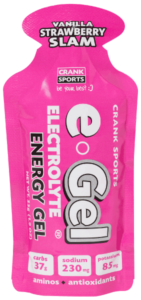
The problem with most gels is that they are either high in sugar (see video above), or they don’t have the electrolytes you need. Electrolytes are critical to help maintain hydration and avoid muscle cramps and injuries. Only e-Gel Electrolyte Energy Gel gives you everything you need right in the gel!
- 4 x Electrolytes to avoid cramping and injuries
- Loaded with complex carbs, just what you want!
- Low in sugar to avoid spikes and crashes
- Multi-carbs source (read why you want a little fructose)
- Thinner consistency, no more choking on thick gels!
- 150 calories per pack, fewer to carry, less trash to deal with
- no artificial colors, sweeteners or sugar substitutes
- no caffeine (read why)
- no fat, fiber or protein (video)
- aminos and antioxidants to reduce lactic acid, soreness and speed recovery
- large easy-grip top
- we beat the competition (see for yourself)
- customer proof (read below)
what about training?
Obviously anyone attempting to run a marathon needs to properly train. We like to say that if you don’t put in the training miles you won’t even make it TO the wall! That said, marathon courses are full of runners that have followed a training program and yet they still hit the wall.

Ready to try e-Gel? Enter your e-mail address below and we’ll instantly display a coupon code for additional savings on your first order

no stomach issues!
Adam Fleisher
First time user. I have Crohn’s, Barrett’s esophagus, hiatal hernia, GERD and vertigo. I was hesitant about trying the e-Gel products. I ordered a sample box. Started with Radical Raspberry (I am not a raspberry fan). You made a believer out of me.
Your product has a good taste, not thick nor sticky, and no dips in energy. (As I was putting the rapper in a bag to discard later, I got some gel on my fingers. No water needed and no sticky fingers). No GI issues, no reflux, and no bloating. Can’t wait to try another flavor!
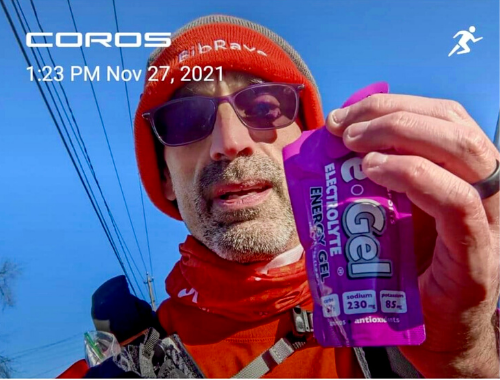
Many people have problems with other energy gels upsetting their stomach, but very few people have as many medical issues to deal with as Adam does, making it even more challenging. If e-Gel works for Adam we’re 100% confident that it’ll work for you as well! But if you’re not convinced, read more stories like Adam’s
reduce cramping and injuries!
Keith Castleton
sustained energy without the bonk!
Steve and Lynna Lyn
no more choking on thick energy gels!
Jeff Domenico
if you found this useful please share!
related resources
gels, drinks, chews ... what's best for your sport?
Use our Sherpa Nutrition Guide tool to get your nutrition dialed in. Just plug in your sport, problems you’re having (cramping, stomach issues, running out of energy) and Sherpa will give you a detailed person guide. Free, quick and easy!
what is an energy gel and who should use them
Many people are not fans of energy gels at first because they can be sticky, thick and hard to get down. Why would anyone use an energy gel? Why not just stick to energy bars and sports drinks? All good questions… read on
when to use energy gels and sports drinks and can they be used together
If you decide to use e-Gel and e-Fuel together (or any energy gel and sports drink), follow these guidelines for best results.
hydration and proper use of energy gels
Before building an energy gel into your training and competition program, it is critical to understand the importance of proper hydration.
energy gels are a better choice than bars and chews
Protein bars, energy gels, chews, hydration drinks, fruit … what should you use? Making the right selection can significantly improve performance.
marathon training with e-Gel
ingredient articles
fat and protein during your race, don't do it!
In order to achieve optimum performance in any endurance sport you need to maximize oxygen delivery to the working muscles. What you eat plays a significant role.
fructose, you need some!
Fructose often gets a bad rap, but using it properly will actually give you an advantage, learn how.


